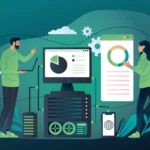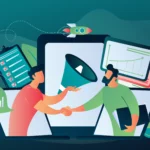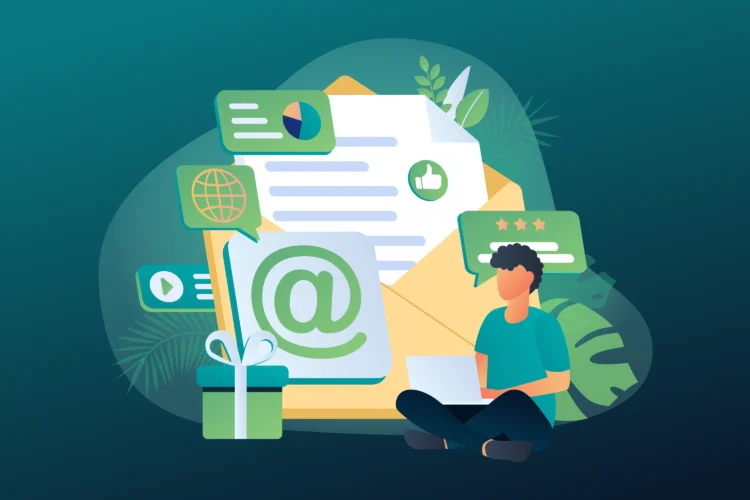
It’s a question that every SaaS founder and marketer faces. Capturing attention in the crowded digital marketplace is only the beginning; keeping it is the true difficulty. The answer is frequently found on the very first digital touchpoint a potential client encounters – the landing page.
The landing page is much more than a “welcome mat.” The handshake can either establish trust or make potential clients wary. A high-converting landing page does more than just present your product; it simplifies complex products, highlights unique selling aspects, and gently guides visitors to action. In essence, it serves as a link between fascination and conversion.
Having architected over 500 landing pages for B2B SaaS products, we’ve garnered unique insights into the nuances of customer behavior. The landing page is often a brand’s first impression, acting as a silent salesperson, setting the stage for user experience and, ultimately, conversion.
Here are some critical behavioral insights from our journey:
- Instant Value Recognition: Today’s B2B customer doesn’t linger. If your landing page doesn’t present value within the first few seconds, you risk losing a potential high-quality lead.
- Trust Indicators Matter: In a market proliferated with countless solutions, credibility is king. Awards, testimonials, and security badges aren’t just ‘nice-to-haves’—they’re crucial trust-building elements.
- Brevity is Key: B2B SaaS customers, often decision-makers, are swamped. They prefer succinct, clear information over convoluted sales pitches.
As you embark on your SaaS journey, remember: the high-converting landing page isn’t just about aesthetics. It’s a strategic blend of market insights, understanding customer behavior, and ongoing conversion rate optimization.
In this article, we’ll walk you through the best practices and exact steps you should take to create a SaaS landing pages that converts.
First. Define your landing page goals
Define the goals you want to achieve with the landing page.
The most common conversion goals for SaaS businesses are
– free trial sign up
– lead magnet download
– webinar registration
– monthly, annual or lifetime paid subscription
Landing page structure: Importance of Page Structure and Layout
The structure and visual appeal of your landing page are critical to its efficacy. A well-structured layout provides for easy navigation, allowing visitors to find what they’re searching for, and gently guides them to the intended action – whether that’s signing up for a trial, downloading a resource, or scheduling a demo call with a company representative.
Here are a few tips for optimizing your page structure and layout:
- Visual hierarchy: Arrange the main landing page elements in the order of their importance. The most important information, such as your value proposition and major CTA, should be prominently displayed.
- Whitespace: Don’t overcrowd your page. Whitespace (the empty space around components) used widely improves reading and focus.
- Simplicity: Adopt a simple and clean design. At a glance, visitors should grasp what you offer and what they need to do next. If you overdesign, the offer will fade into obscurity.
- Design consistency: Maintain a consistent design throughout the page. Uniformity in colors, fonts, and styles can enhance the overall user experience and reinforce your brand identity.
Product-led VS Sales-led landing pages
Here’s the where most of the people made a crucial mistake – identify what is your go-to-market strategy. The layout structure, messaging, design, call to action strategy of your landing page can vary based on your SaaS go-to-market strategy, particularly if your SaaS business model is product-led or sales-led.
Here are the key differences between these two models you should be aware of before you start crafting landing page:
Product-Led SaaS Landing Page
In a product-led approach, the product is the main driver of customer acquisition, expansion, and retention. The product-led SaaS companies typically offers a freemium version or a free trial, and users can see value before making a purchase decision ,ie. make monthly or annual subscription.
If want to build landing landing page for Product-led SaaS your should mainly focus on:
- Immediate value demonstration: The landing page needs to show the product’s value upfront and quickly. It often includes a demo video or interactive tour to provide landing page visitor an immediate sense of what to expect from the product
- Frictionless sign-up process: The call-to-action (CTA) is usually a prompt to sign up for a free trial or to start using a freemium version of the product right away. The sign-up form should be simple and straightforward to facilitate easy access to the product.
- User testimonials and case studies: To build trust, these landing pages feature testimonials from users who have derived value from the product. Case studies provide detailed examples of how the product solves real-world problems.
Sales-Led SaaS Landing Page
In a sales-led approach, a dedicated sales team or sales development representative drives customer acquisition. The product is typically high-touch, more complex, and often caters to enterprise-level clients.
If want to build landing landing page for Sales-led SaaS your should mainly focus on:
- Detailed feature breakdown: Since the product is typically more complex, the landing page provides an in-depth overview of the features and their benefits. It aims to intrigue prospects enough to want to learn more.
- Authority and trust-building: These landing pages often feature logos of enterprise-level clients, industry awards, or security certifications to establish credibility and reliability.
- Consultation or demo request: The main CTA often leads to a request for a personalized demo or a consultation call. The sign-up form may ask for more information, like company size or specific needs, to ensure that the sales team can provide a personalized response.
In conclusion, to ensure optimal conversion efficacy, match your landing page design, content and CTA with your go-to-market strategy.
Copywriting & Messaging
Many of us believe that a well-designed landing page will increase conversions, but this is not always the case. In fact, over-designed landing pages might generate reader fatigue, leaving the potential customer unsure of how your product works and what benefits he will gain from using it.
There is a method called “Content population” that can help you avoid making this kind of mistake. Content population is the way in which your page design helps to deliver your message, textually and visually.
In order to effectively communicate the benefits of your SaaS product to potential users, copywriting and messaging are crucial. There is a good probability that your conversion rates will be extremely poor if the messaging style and tone of voice don’t match the narrative and visitors’ pain problem.
Here’s a few tips on how to improve your landing page messaging:
- Create an attention-grabbing headline: The backbone of a high-converting landing page is persuasive copy. The headline must be attention-grabbing and encapsulate your value proposition succinctly. Use compelling subheadings to maintain interest and guide readers through your offering.
- Put the benefits first: While adopting copywriting to convey product features, don’t focus on functionalities – focus on benefits. Rather than just listing what your product does, explain how it solves your audience’s problems and adds value to their businesses.
- Include emotional triggers: Use persuasive triggers such as scarcity (limited time offer), authority (endorsements from industry leaders), and social proof (testimonials, case studies) to build trust and urge action.
- Call to action text: Just make it clear and concise.
Building High-Converting Sign-Up Forms
Sign-up forms are where the conversion action happens, making them one of the most critical components of your landing page. A well-thought-out page structure and user-friendly sign-up forms can significantly enhance your landing page’s effectiveness, leading to better engagement, higher conversion rates, and ultimately, more successful customer acquisition.
Here are some tips for building high-converting sign-up forms:
- Keep it Short: Ask only for essential information. Long forms can be off-putting, causing big drop-off rates.
- Clear CTA: Use a clear, compelling call-to-action for your form submission button. Instead of a generic ‘Submit’, consider more engaging CTAs like ‘Start my free trial’ or ‘Join the community’. An effective CTA button can make or break your conversion rate. Pro tip – use actionable language that creates a sense of urgency or excitement.
- Offer Incentives: If appropriate, offer an incentive for signing up, such as a free ebook, a discount code, or early access to new features.
- Error Handling: Make sure any form errors (like an incorrectly formatted email address) are clearly communicated and easy to fix.
- Personalize: Instead “business email address” write “my best email address”
- Include risk removals: Including risk removals can significantly improve your conversion rates. There are a lot of benefits that you can get including risk removals. Some of them may be focused on building trust by assuring your users that their data will be handled securely. Other may be focused more on user experience where you commit to offering a streamlined registration and onboarding process.
- Use Customer Testimonials and Social Proofs: Placing social proofs and customer testimonials near the sign up form helps build credibility and trust. These assets should align with your main USPs and reinforce the benefits you’ve promised.
SaaS Landing Page Best Practices
1. Wireframe page in Miro or Figma Jam
Before you dive into the design and copywriting phase, it’s crucial to structure your SaaS landing page. At our agency we are calling this process wireframing. Tools like Miro or Figma Jam can assist in creating a wireframe – a simple, visual guide that represents the skeletal framework of your landing page. Wireframing allows you to plan your layout, define your information hierarchy, and visualize the user journey, all without distractions of colors, fonts, or images. This step ensures a strong foundation for your page flow and structure.
2. Leverage Website Builders
If your SaaS marketing team lacks a dedicated developer that can help you code the landing page (we understand that most dev teams are focused on building the product). That’s where website builders come in. Landing page builders like Webflow, Unbounce, Elementor, Landigi, and others, offer user-friendly drag-and-drop interfaces and customizable templates, empowering you to create professional-looking landing pages without the need for extensive coding skills.
Webflow is always our first pick for B2B tech and SaaS companies as it has the most advanced design features and is ideal for creating custom landing pages from scratch. Unbounce excels in A/B testing and conversion rate optimization, with features to create highly effective landing pages. Elementor works seamlessly with WordPress, providing a wide array of widgets and templates.
Our advice is to conduct some research and pick the landing page builder that best meets your long-term requirements.
3. Perform A/B Test for Conversion Rate Optimization
Once your landing page is live, you start running marketing campaigns, and you start receiving traffic. It’s time for A/B testing! Test experiments implies creating two or more versions of your page with one differing element (like CTA text or image placement) and understand which performs better by the time. Use tools like Optimizely or Google Optimize to run your tests. Monitor your conversion rates closely, and apply your findings to continually improve your landing page experience.
Where A/B test experiments should be implemented
- Landing page headline. Because the headlines are the first thing a visitor encounters when he gets at the landing page, aim to tailor them as much as possible to the target persona. You can accomplish this in a variety of ways, such as identifying the problem, demonstrating a direct result in the form of a number or percentage, or even taking into consideration the situation of the market and addressing it.
- Sign-up or demo forms. This is where the conversion happens and where your potential customers enters the sales funnel.
- CTA buttons. A/B testing variations should include CTA text, color, animations etc.
- Design assets. It is not always the case that the most edgy design converts the best. Try testing static graphics against animated illustrations to see which your client persona finds more intuitive.
4. Set Up Analytics Tracking
Understanding user behavioral patterns on your landing page is essential for further optimizations and improvements. In order to properly measure the success of your landing page and gain insights into what works better and what doesn’t, set up conversion tracking for free trial sign up, ebook download, etc. and send those actions as events to Google Analytics, Mixpanel, Amplitude or another analytics tool. Don’t forget to install a heat-mapping and recording tool such as Microsoft Clarity or Hotjar, which can help you see the behavior of people on the site through heat maps and recorded sessions.
Conclusion
Our conclusion is the most SaaS companies have trouble creating high-converting landing pages, and optimizing them for further success. The most common reason we found is that they can connect three main aspects together which are messaging, design and in one logical sense
Author
Jovan
Creating growth strategies for B2B SaaS products is one of my specialties. Over the last seven years, I've worked closely with a number of SaaS founders, VPs of marketing, and marketing managers to help them scale their businesses faster by applying growth marketing approaches. Goals. Grow and expand the agency to help even more B2B SaaS businesses.








